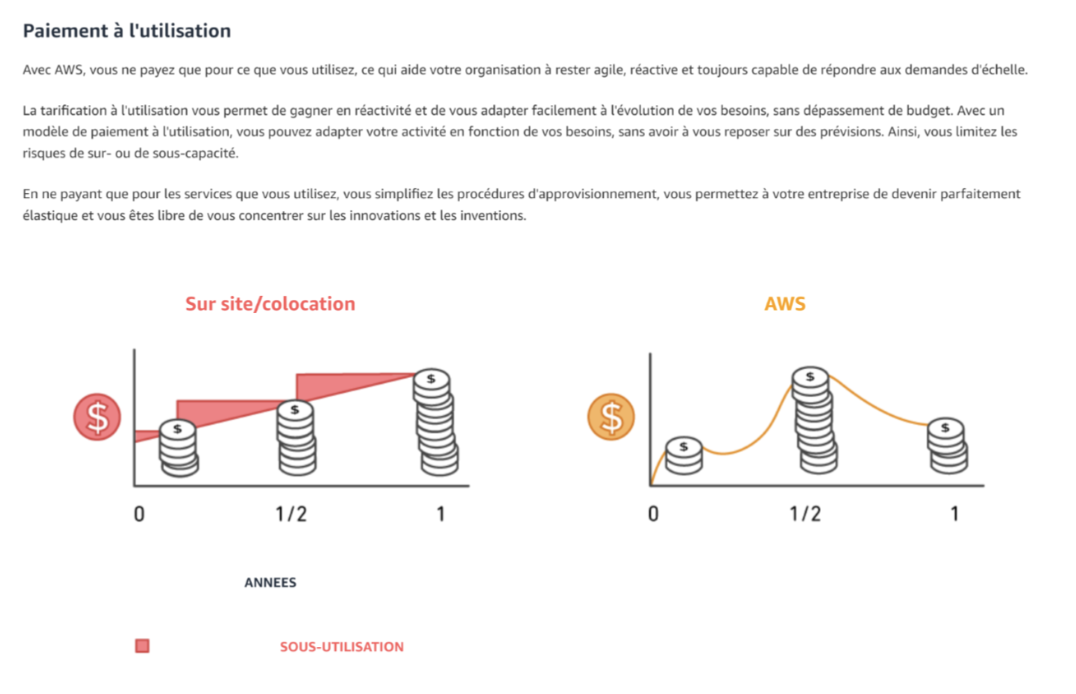The subscription economy is growing, as consumers and businesses often prefer to pay for use rather than ownership. Suppliers must therefore adapt their offer and pricing.
In parallel, usage-based pricing is a growing trend that consumers are flocking to. It requires an agile billing solution that can handle pay-per-use revenue and a wide variety of subscriptions.
What is usage-based pricing?
Usage-based pricing is a business model where the user only pays when they use the service, rather than having to pay a lump sum (subscription, rent, etc.) or buy it. So, the more a customer uses the product or service, the more they pay. And vice versa. Overall, it’s a fair way to treat the customer.
Amazon Web Services (AWS) offers this type of pricing:

This allows, for example, a start-up in the launch phase to avoid buying servers. And to access only the storage and computing power it needs, thanks to Amazon’s infrastructure. Then, as the company grows, it can increase its consumption, with a payment directly correlated.
How does usage-based pricing work?
In the pay-per-use model, the ownership and responsibility for the product or service lies with the company itself, and the customer pays a fee for on-demand use.
Pay-per-use is not new. But today’s technology makes it much easier to develop. For example, with the rise of the IoT (Internet of Things), tracking product usage has become simpler, more accurate and cheaper. Usage-based pricing is now a more viable option for industries that previously did not have the technological capabilities to derive value from it.
And on the customer side, the enthusiasm is strong: they like the idea of only paying for the services they need and use. This is the case, for example, in transport. We talk about it in our article on MaaS (Mobility as a Service).
What are the advantages of usage-based pricing?
On the supply side, this model makes it easier to track the use of their products or services. Companies obtain valuable data to improve their value proposition.
In our opinion, the most important advantage is customer loyalty. With usage-based pricing, the connection with your users becomes more service-oriented, rather than one-off sales. In addition, the value of your offer increases continuously, with additional benefits (such as installation, maintenance, or support) that create more value for the customer. These benefits help to reduce churn and increase loyalty.
On the buyer side, this model entails less responsibility. The risks associated with ownership and maintenance are concentrated on the supply side. The cost of products and services becomes more accessible and transparent. Also, there is no large upfront payment required for simple access.
“Pay-per-use allows you to be more responsive and easily adapt to changing needs, without overspending. With a pay-per-use model, you can scale your business up or down as required, without having to rely on forecasts. This helps you avoid the risks of over- or under-capacity.” Source: AWS
Usage-based pricing reduces the costs of entering new markets or new customer segments (see the example in paragraph 1).
Another advantage for buyers is constantly improved products and services. As we saw above, to make this model fully viable, companies rely on customer loyalty. This means that they are constantly improving their offer based on customer data.
In conclusion, with the rise of the functional economy, companies are increasingly adopting recurring revenue business models. This business model allows them to accelerate their predictable growth and achieve higher financial valuations. But to succeed in retaining their customers, implementing innovative pricing (such as pay-per-use) is far from obvious. To achieve this, companies must go beyond traditional ERP systems. And implement new solutions, adapted to the management of subscription and usage revenue. This requires the implementation of an agile billing platform.
